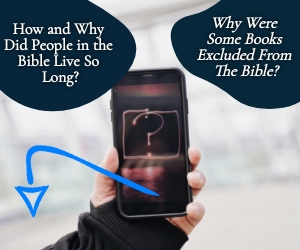The life of Rahab is a picture of our own salvation, showing anyone can move from misery into the light.
Rahab
 The life of Rahab is a picture of our own salvation, showing anyone can move from misery into the light. Rahab is one of the most remarkable women in the Hebrew Scriptures. She was a Canaanite prostitute who lived ca 1406 B.C. in Jericho, converted to Judaism and was in the lineage of Christ.
The life of Rahab is a picture of our own salvation, showing anyone can move from misery into the light. Rahab is one of the most remarkable women in the Hebrew Scriptures. She was a Canaanite prostitute who lived ca 1406 B.C. in Jericho, converted to Judaism and was in the lineage of Christ.
She was an intelligent and “street smart” woman who understood how Jericho’s social classes, military and political protocol operated. Her home was located inside one of the Jericho walls (Joshua 2:15) and she was known by royalty, residents and travelers. Rahab was aware of what was going on throughout the community and did not miss much entering or leaving the gates.
Paul stated she was a woman of faith (Hebrews 11:3) and James acknowledged she was justified by works (James 2:25). The name Rabab means “wide” or “spacious” and Josephus stated that Rahab owned an Inn at Jericho (William Winston, Antiquities of the Jews, 104). [1]
The Popular Prostitute
Comparing Hebrew and Greek Texts
According to Strong’s Concise Dictionary of the Words in the Hebrew Bible, the Hebrew word in Joshua 2:1 describing Rahab as “harlot” was “Zanah,” which suggests she likely participated more in adultery than fornication, although she practiced both “continually” (Strong, 1990, 38). [2]
The word “harlot” used by Paul and James is the Greek word “pornē,” (Strong, 73), a term from which the word pornography is derived.
Evaluating these texts combined with the context in which Rahab is described, it is reasonable to conclude that an accurate evaluation of her lifestyle is that she was a common street prostitute who attained popular status among the diverse classes of Jericho.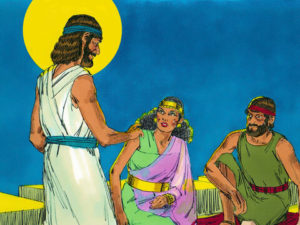
Rabbinic Commentary
According to the Zevachim, Rahab was age 50 when she encountered the spies, was about 10 at the time of the Exodus and the two spies played an important part in her conversion. The Gemara states Rahab’s childhood was taken from her at a very early age. (The William Davidson Talmud Zevachim, 116b:2). [3]
Dr. Amy Cooper Robertson in her article, Rahab the Faithful Harlot, quotes that the Gemara replies that “There was no minister or prince that did not pay a visit to Rahab the Harlot” (Robertson 2019). [4] She also cites the rabbinic commentator, Malbim who stated that Rahab’s “Name was known to all of the great men in the land. They would reveal the secrets of the land to her.” (Robertson 2019).
Rahab’s Story
Her story opens when two Israeli spies entered Jericho and found their way to her home. Although their names are not mentioned in Joshua, according to a commentary noted by Tamar Kadari in her article, Rahab: Midrash and Aggagah, she identifies them as Phinehas and Caleb (Kadari 1999). [5]
The king was immediately informed that two strangers had entered Jericho, disrupting their plans to evaluate the city. Instead, they found themselves running for their lives until they returned to their camp. The king asked Rahab to bring the men to him. She lied and told him they already left Jericho, but what she did was hide them on her roof in stalks of flax.
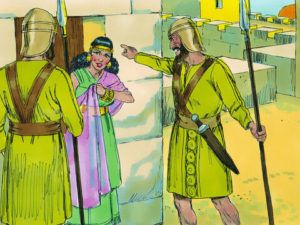 Rahab told the spies she had heard their God had parted the Red Sea and performed other miracles that melted her heart. She asked them to spare her and her family from the upcoming city’s destruction. They told Rahab to tie the same red rope to the window she was going to use to let them down the wall for their army to see and rescue her. Perhaps the spy’s primary mission was not so much to evaluate Jericho’s layout as it was to meet Rahab and influence the final steps of her conversion and rescue.
Rahab told the spies she had heard their God had parted the Red Sea and performed other miracles that melted her heart. She asked them to spare her and her family from the upcoming city’s destruction. They told Rahab to tie the same red rope to the window she was going to use to let them down the wall for their army to see and rescue her. Perhaps the spy’s primary mission was not so much to evaluate Jericho’s layout as it was to meet Rahab and influence the final steps of her conversion and rescue.
Rahab advised them to hide in the distant hills for three days, which was in the opposite direction of the Israeli camp. She knew Jericho’s military procedures well enough to know that the soldiers would return before three days. The spies did precisely what Rahab recommended. They safely returned to their camp and Joshua made good on the promise to rescue Rahab and her family.
Rahab’s Red Rope of Hope
Some Christian scholars and historians through the centuries have interpreted the red rope in every way conceivable. However, sometimes in the Bible, a rose is simply a rose. Concerning Rahab, the rope’s color was solely about a harlot using the ancient signature color of her profession to lower a couple of men from her window, which she probably kept on standby in case of an emergency. Throughout her Jericho experience, she most certainly had to deal with angry wives and mothers stopping by to cause trouble on occasion. The color also informed citizens who saw someone being lowered that they were not a danger to anyone, just Rahab getting folks safely out of there, which likely protected the spies from being identified as Israeli enemies.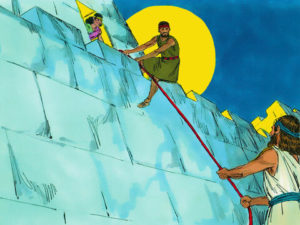
Rahab and Boaz in Matthew’s Genealogy
Rahab is often interpreted in Matthew’s opening genealogy (Matthew 1:5) as the birth mother of Boaz, although she was no doubt intended by Matthew to be the same one who was in the Jericho story. However, the timeline of the Jericho destruction occurred ca 1406 B.C., but Boaz was born about 1100 B.C. Considering how ancient Jewish genealogies were written, it is doubtful that Rahab was the birth mother of Boaz. However, it is more likely that Rahab was either the great or second great grandmother of Boaz.
According to Dr. Peter Goeman, Professor of Old Testament and Biblical language at Shepherd’s Theological Seminary, Jewish genealogies regularly skip generations, especially when the writer had a specific objective in mind. Generations were also skipped from the genealogy of Moses in chapter 6 of Exodus (Goeman, 2022). [6]
Rehab the Social Outcast
By the time the spies entered Jericho, Rahab, at approximately age 50, was thoroughly discontented with her profession and she had long since realized that worshipping the Canaanite deities of stone and wood was meaningless. Although she had attained notoriety and status among the kingdom’s classes, she was still basically perceived as a social outcast living a harlot’s lifestyle. She was weary of playing the games and dealing with the conflicts and resentments of her profession. However, YHWH had been working in her life long before the spies met her. The stories she heard about what God did for Israel did not terrify her, God worked through them to change her.
Loss and Greater Gain
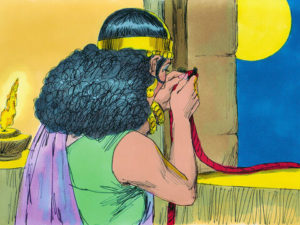 Apart from Rahab’s immediate family, she lost almost everything when Jericho fell. However, God had greater plans for her than she initially realized, giving her far more than she lost. Rahab entered the Promised Land with the Israelites, where she remained and became a role model of God’s love and mercy. Israel unconditionally welcomed Rahab and supported her intermarriage into the royal family of Judah. She experienced a fulfilling life, had children and for the remainder of her years was a witness to Israel of Jericho’s event and how the living God brought about her conversion.
Apart from Rahab’s immediate family, she lost almost everything when Jericho fell. However, God had greater plans for her than she initially realized, giving her far more than she lost. Rahab entered the Promised Land with the Israelites, where she remained and became a role model of God’s love and mercy. Israel unconditionally welcomed Rahab and supported her intermarriage into the royal family of Judah. She experienced a fulfilling life, had children and for the remainder of her years was a witness to Israel of Jericho’s event and how the living God brought about her conversion.
Conclusion
From a Christian perspective, Rahab’s experiences with God are significant and the relationship they shared is based on the dynamics of how Christ interacts with us today. He is always there, even if we do not feel His presence. God is often working in between the lines unseen for our benefit. He brings people into our lives that make a difference and removes others who are stumbling blocks to our well-being. He responds to our sincerity and reaches out to us. Whether we lose individuals or possessions, God comforts our mourning, more than replaces our losses and reveals to us healthier lifestyle choices.
Author’s Bio:
Lewis Hales is retired journalist, columnist and clinical therapist with a bachelor’s degree in biblical studies and has master’s degrees in education and counseling. Lewis began his early career as a minister for 6 years and later specialized in adult psychiatric disorders and addiction as a counselor and clinical supervisor over 20 years. Lewis recently retired from of The Celtic Collection Program, a historical and living history corporation after serving as its CEO for 20 years.
Here is some related reading for you: Rahab in the Bible: Profile Story and Lessons
1. Flavius Josephus. Antiquities of the Jews. Josephus Complete Works. Translated by William Whiston. Kregal Publications, Grand Rapids, Michigan, 1974
2. James Strong. Strong’s Exhaustive Concordance of the Bible, Hebrew and Aramaic Dictionary of the Old Testament, Thomas Nelson Publishers, Nashville, Tennessee, 1990: 38.
3. “The William Davidson Talmud.” Sefaria/Zevachim, 116b:2. Project Sefaria digitalized and released translations into the public domain, 2015. https://www.sefaria.org/Zevachim.116b.2?lang=bi.
4. Amy Cooper Robertson, “Rahab the Faithful Harlot” TheTorah.com, 2019. https://thetorah.com/article/rahab-the-faithful-harlot
5. Kadari, Tamar. “Rahab: Midrash and Aggadah.” Shalvi/Hyman Encyclopedia of Jewish Women. December 31 1999. Jewish Women’s Archive. http://jwa.org/encyclopedia/article/rahab-midrash-and-aggadah>.
6. Peter Goeman. “Was Boaz the Son of Rahab?” The Bible Sojourner, (Podcast) December 2, 2022. https://petergoeman.com/was-boaz-the-son-of-rahab/









 Welcome to What Christians Want To Know! The mission of this site is to equip, encourage, and energize Christians. Look for regular updates including Bible Verses, Bible Stories, Christian Quotes, Christian Answers, and much more. Find out
Welcome to What Christians Want To Know! The mission of this site is to equip, encourage, and energize Christians. Look for regular updates including Bible Verses, Bible Stories, Christian Quotes, Christian Answers, and much more. Find out 





